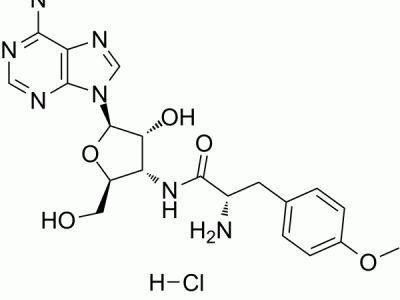Puromycin dihydrochloride
Puromycin dihydrochloride (CL13900 dihydrochloride) 是一种氨基核苷类抗生素,抑制蛋白合成 (protein synthesis)。

体外研究(In Vitro)
Puromycin blocks protein synthesis after aminoacyl-sRNA formation, and at the same time it leads to the accumulation of small peptides. Both of these effects appear to be due to the splitting of ribosome-bound peptidyl-sRNA,4 which results in release of incomplete peptide chains.[1].
Puromycin, an analog of the 3' end of aminoacyl-tRNA, causes premature termination of translation by being linked non-specifically to growing polypeptide chains. Puromycin has two modes of inhibitory action. The first is by acting as an acceptor substrate which attacks peptidyl-tRNA in the P site to form a nascent peptide. The second is by competing with aminoacyl-tRNA for binding to the A' site[2].
When used in minimal amounts, puromycin incorporation in neosynthesized proteins reflects directly the rate of mRNA translation in vitro. Puromycin immunodetection is an advantageous alternative to radioactive amino acid labeling. It allows the direct evaluation of translation activity in single cells by immunofluorescence microscopy and in heterogenous populations of cells by fluorescenceactivated cell sorting
分子量:544.43
Formula:C22H31Cl2N7O5
CAS 号:58-58-2
来源:Streptomyces alboniger
运输条件:Room temperature in continental US; may vary elsewhere.
储存方式:
4°C, sealed storage, away from moisture
*In solvent : -80°C, 6 months; -20°C, 1 month (sealed storage, away from moisture)
参考文献
[1]. Nathans D, et al. Puromycin inhibition of protein synthesis: incorporation of puromycin intopeptide chains. Proc Natl Acad Sci U S A. 1964 Apr;51:585-92.
[2]. Miyamoto-Sato E, et al. Specific bonding of puromycin to full-length protein at the C-terminus. Nucleic Acids Res. 2000 Mar 1;28(5):1176-82.
[3]. Schmidt EK, et al. SUnSET, a nonradioactive method to monitor protein synthesis. Nat Methods. 2009 Apr;6(4):275-7.










